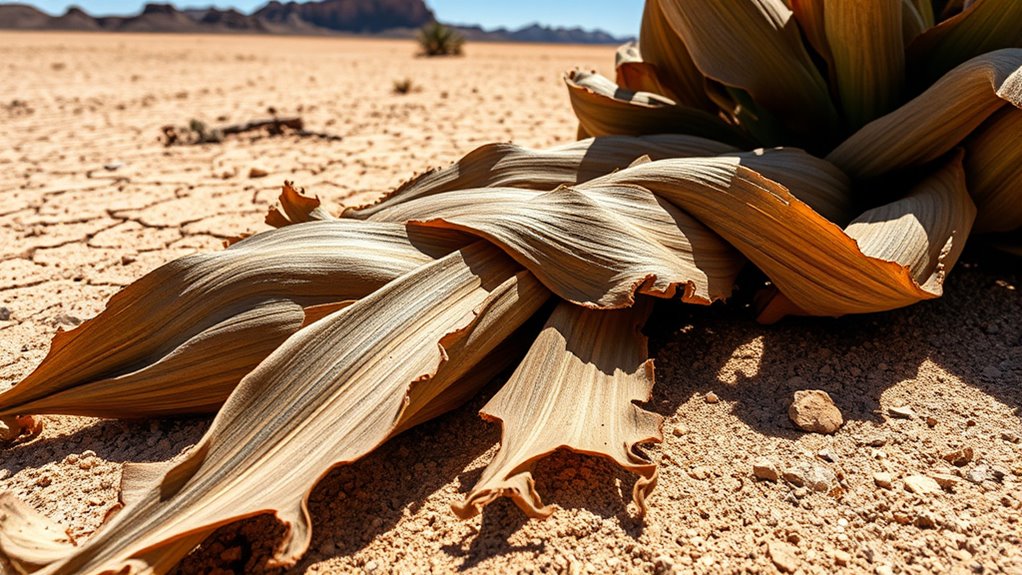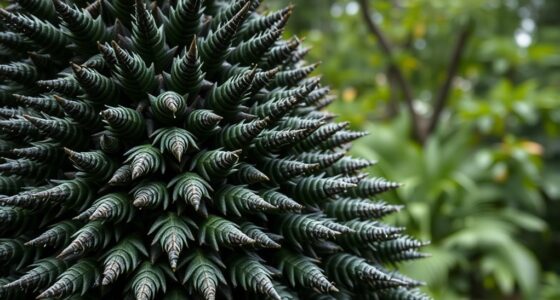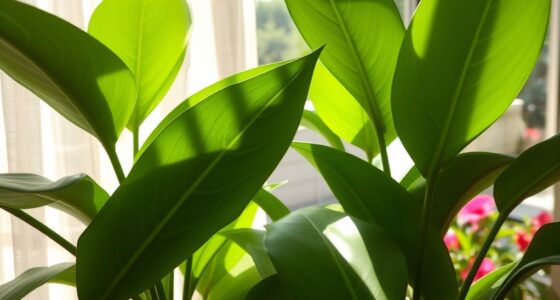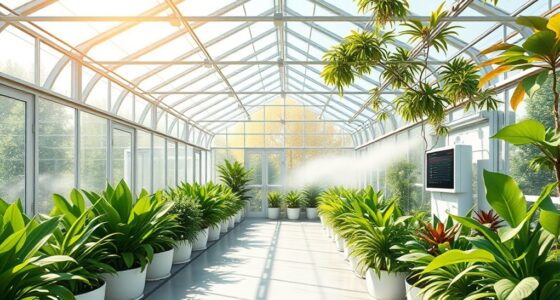Welwitschia is a desert plant that defies normal rules with just two long, strap-like leaves that grow continuously and can live for over a thousand years. Its unique structure helps it conserve water, while deep roots and leaves that collect moisture from fog and dew keep it alive in harsh conditions. This resilience and strange growth pattern make Welwitschia a true survivor of extreme environments. Discover more about how it breaks the rules of plant life as you explore further.
Key Takeaways
- Welwitschia has only two long, strap-like leaves that grow continuously over its lifespan.
- Its leaves can last over 1,000 years, twisting and developing a leathery texture for water conservation.
- The plant adapts by storing water in its stem and roots, and roots reach deep for underground moisture.
- Its unique growth pattern breaks conventional plant development rules, symbolizing resilience in harsh environments.
- Welwitschia’s survival strategies exemplify nature’s ingenuity in thriving under extreme desert conditions.

Have you ever wondered how a plant can survive in one of the harshest environments on Earth? Meet Welwitschia, a desert marvel that defies expectations. Unlike most plants, which grow quickly and produce new leaves annually, Welwitschia’s leaves are extraordinary. It only has two long, strap-like leaves that grow continuously over its lifetime, which can span over a thousand years. These leaves stretch out for meters, twisting and turning as they age, creating an almost surreal appearance in the barren desert landscape. You might think such a long lifespan and unusual leaf structure wouldn’t be sustainable, but Welwitschia has adapted in remarkable ways to thrive where most plants cannot.
The key to its survival lies in its leaves’ unique features. These leaves don’t grow from a central point like typical plants; instead, they emerge from the base and grow outward indefinitely. Over time, they develop a tough, leathery texture that helps reduce water loss—a vital trait in the desert’s dry climate. The leaves are covered with tiny hairs that reflect sunlight, further protecting the plant from extreme heat. Their length and flexibility allow them to sway with the desert winds, minimizing damage and conserving energy. As they age, the leaves split and tatter, but new growth continues from the base, maintaining the plant’s overall structure. This ongoing growth means Welwitschia doesn’t need to shed old leaves; instead, it simply keeps adding new sections, making it a living record of centuries. Additionally, its ability to store water in its stem and roots is crucial for its long-term survival.
You might wonder how such a plant manages to gather enough water to sustain itself over such a long period. Welwitschia’s roots reach deep into the desert floor, tapping into underground water sources that are often inaccessible to other plants. Its leaves also play a role in collecting moisture from fog and dew, which are common in its environment. When it rains, the plant quickly absorbs water through its leaves and roots, storing it in its thick stem. This resilience is vital because rain is infrequent and unpredictable in the Namib Desert, where Welwitschia calls home. The plant’s ability to survive droughts and harsh sunlight is extraordinary, rooted in a combination of structural adaptations and efficient water use.
In essence, Welwitschia’s leaves are more than just a feature—they’re a tribute to nature’s ingenuity. They break the rules of typical plant growth, showing that survival doesn’t always follow conventional patterns. If you ever find yourself in the desert and spot a strange, long-leafed plant, you’re witnessing a living relic of evolution’s creativity. This incredible plant reminds us that even in the most extreme conditions, life finds a way to adapt, endure, and flourish. Its unique growth pattern exemplifies how some plants develop unconventional strategies to thrive in extreme environments.
Frequently Asked Questions
How Does Welwitschia Survive Extreme Desert Temperatures?
You might wonder how welwitschia survives extreme desert temperatures. It adapts by developing deep roots that access underground moisture and has broad, strap-like leaves that reduce water loss. Its thick, woody stem stores water, and the plant enters a state of dormancy during the hottest periods. These strategies help it withstand harsh conditions, allowing it to thrive where most plants cannot survive.
Can Welwitschia Reproduce Without Pollinators?
Imagine you’re in a dystopian future where pollinators vanish—Welwitschia can still reproduce. You see, it can self-pollinate or use wind dispersal, making it resilient even without insects. Its unique reproductive ability guarantees survival in harsh deserts. You realize this ancient plant defies modern decline, showing nature’s ingenuity. So yes, Welwitschia can reproduce without pollinators, thanks to its adaptable, self-sufficient strategies that have stood the test of time.
What Is the Growth Rate of Welwitschia Over Centuries?
You’ll find that Welwitschia grows incredibly slowly, often less than a centimeter per year. Over centuries, this means its growth is minimal but steady, allowing it to live for over a thousand years. Its unique adaptation helps it survive harsh desert conditions, conserving energy and resources. So, while you might not see rapid growth, its longevity and resilience make it a remarkable plant that defies typical growth expectations.
Are There Any Conservation Efforts for Welwitschia?
Yes, conservation efforts for welwitschia are in place. You can support local initiatives that protect its natural habitat in the Namib Desert, where it thrives. Researchers and conservationists monitor populations to prevent overharvesting and habitat destruction. Visiting protected areas or supporting organizations dedicated to desert flora helps guarantee this incredible plant’s survival. Your awareness and actions contribute profoundly to maintaining welwitschia’s long-term existence.
How Does Welwitschia’s Root System Support Its Longevity?
Imagine roots like underground anchors, gripping the arid earth with fierce determination. Your Welwitschia’s root system spreads wide and deep, accessing scarce water sources and nutrients. This extensive network acts like a natural reservoir, supporting its incredible longevity. By stabilizing the plant and ensuring a steady water supply, these roots allow it to survive harsh desert conditions for centuries, defying the odds and thriving where few others can endure.
Conclusion
Just like the ancient wisdom of the Sphinx guarding secrets in the desert, Welwitschia defies time with just two leaves spanning a thousand years. It reminds you that sometimes, breaking rules and embracing simplicity can lead to extraordinary resilience. As you marvel at this marvel of nature, remember: true strength lies in enduring what seems impossible. The desert’s silent guardian teaches you that even the most unlikely champions can stand the test of time.










